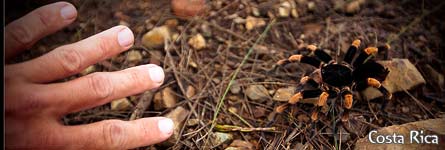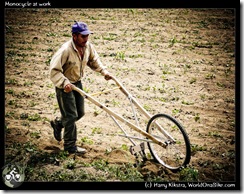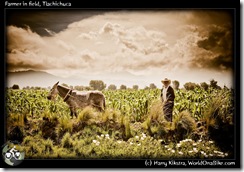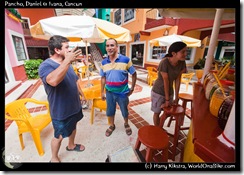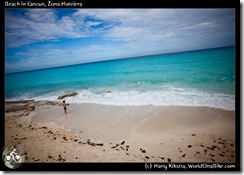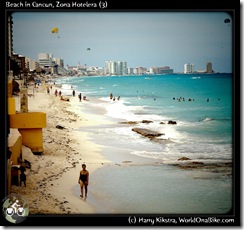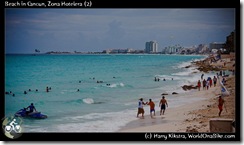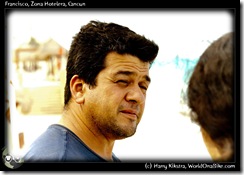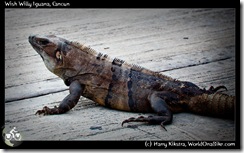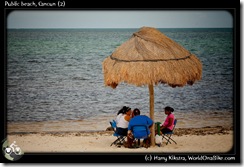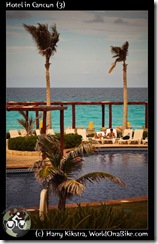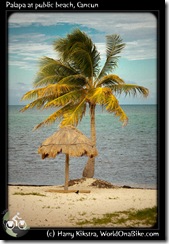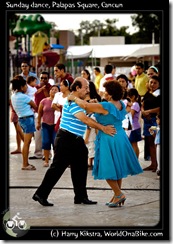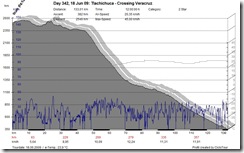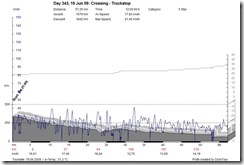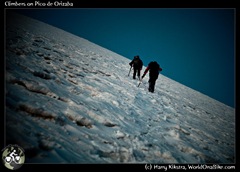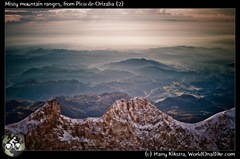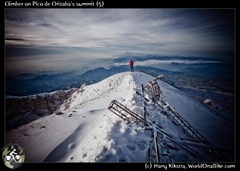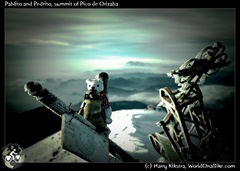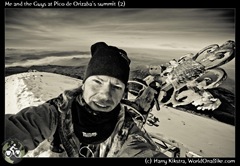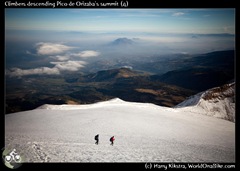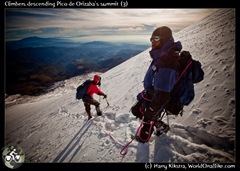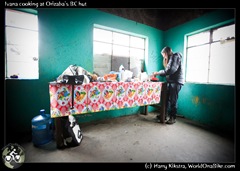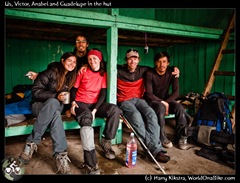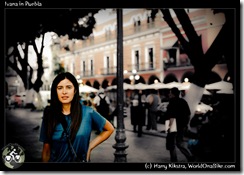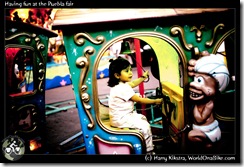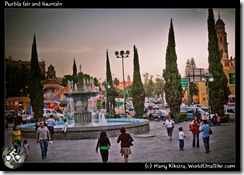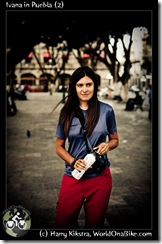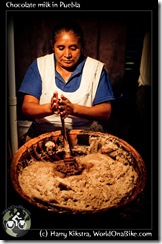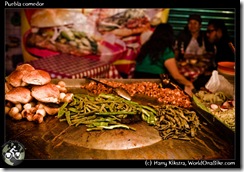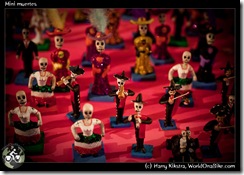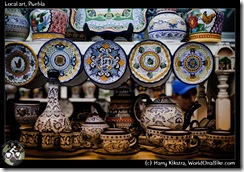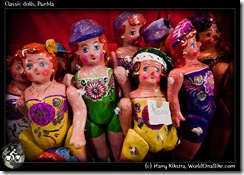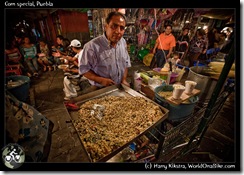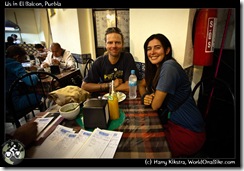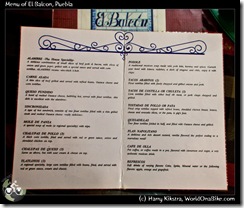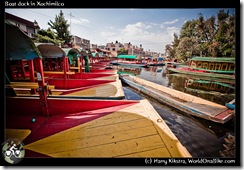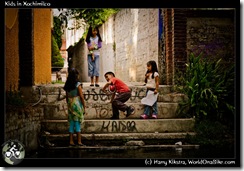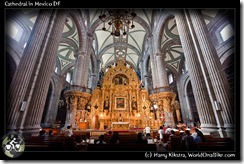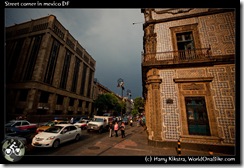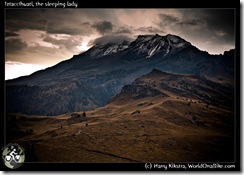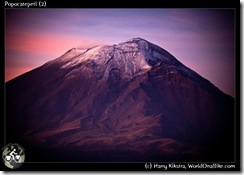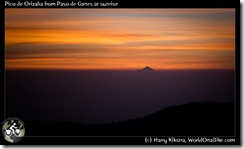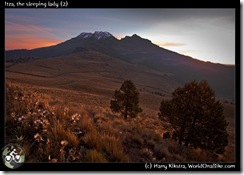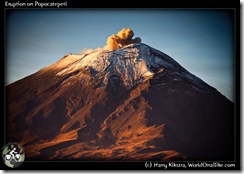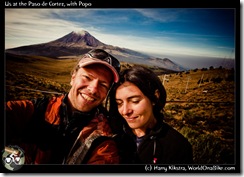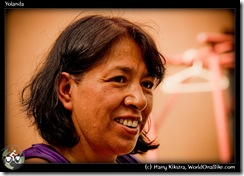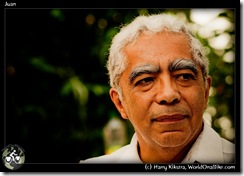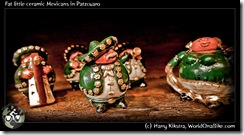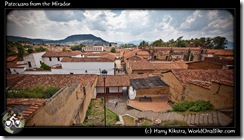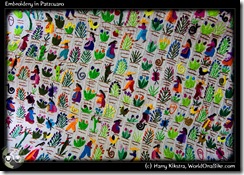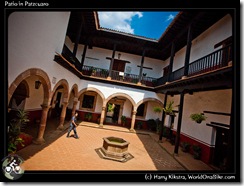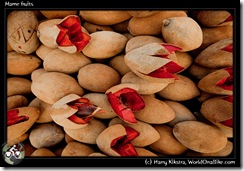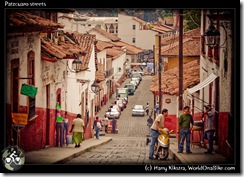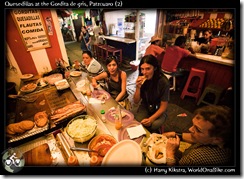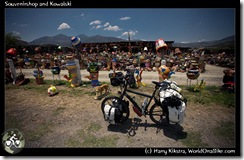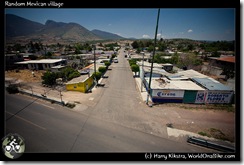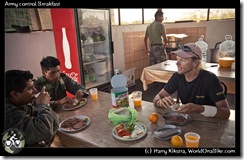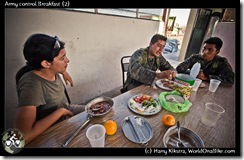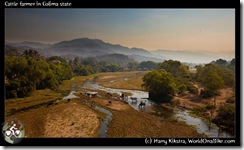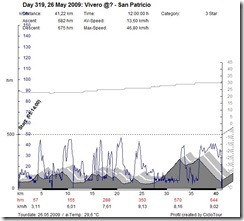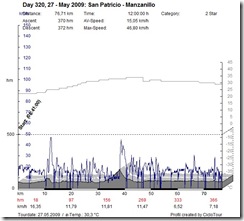Day 342-346, 18-22 June 09: Elections, downhill and to Cancun: World-in-a-Truck
September 22, 2009 by Harry, 2,352 views
Filed under Central Mexico, Mexico, North America, Trip reports, Yucatan Peninsula
18 June 2009: Election tricks, graffiti & handwork
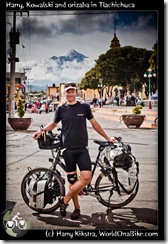 We did a quick tour around the central Plaza in Tlachichuca for some Wi-Fi search and some posing for pictures. I noticed a huge truck unloading hundreds of boxes with a growing crowd gathering around.
We did a quick tour around the central Plaza in Tlachichuca for some Wi-Fi search and some posing for pictures. I noticed a huge truck unloading hundreds of boxes with a growing crowd gathering around.
The boxes contained live chickens and were handed out to the villagers. The magazine salesman that had just treated us to some tacos viewed the scene with a look of disgust.
 “It is the PRI, buying votes. People sell their right to vote for the short term benefit of a chicken. Afterwards they will endure another 4 years of suppression by the rich folks that run the party.”
“It is the PRI, buying votes. People sell their right to vote for the short term benefit of a chicken. Afterwards they will endure another 4 years of suppression by the rich folks that run the party.”
Welcome to the Mexican elections, where votes are bought with live chickens!
 We had already seen signs of the election everywhere. Mexicans in general seem to have a morbid fear of white surfaces, as every wall, of every house, compound or fence always contains graffiti, without exception.
We had already seen signs of the election everywhere. Mexicans in general seem to have a morbid fear of white surfaces, as every wall, of every house, compound or fence always contains graffiti, without exception.
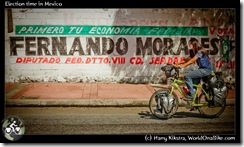 Some times it is just marketing, with the name of the shop or the biggest brands they sell, many times it is just defacing stupid graffiti.
Some times it is just marketing, with the name of the shop or the biggest brands they sell, many times it is just defacing stupid graffiti.
But in the last months before the general elections in July, the majority of all walls have been taken over by the election marketeers promoting their candidates with populist slogans:
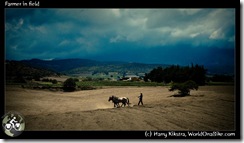 “Your Household Economy comes first!”, “Only we want more jobs for you!” and the classic “Cheaper gasoline for everybody!”.
“Your Household Economy comes first!”, “Only we want more jobs for you!” and the classic “Cheaper gasoline for everybody!”.
We cycled through fields of corn, where old famers were working without any motorized means. All waved when we passed them, on our way to one of the biggest downhills of our entire journey…
After rounding the Ciudad Serdan and climbing some minor hills, we reached the main highway again. The tollbooth attendants did not even see us and so we found ourselves back on the ‘Quota’!
From the highlands to sea level: 400m up, 2500m down in 133km!
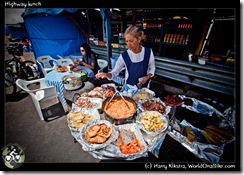 After a quick roadside lunch we started our descent. It was not as relaxed as imagined beforehand as the road was busy and the shoulder filled with rocks and debris of tires and other car parts. Worst of all, we headed into a chilly thick fog, limiting the view in front and behind us to about 40 meters, so we had to brake all the way, wearing our reflective jackets for safety and our rain jackets for warmth.
After a quick roadside lunch we started our descent. It was not as relaxed as imagined beforehand as the road was busy and the shoulder filled with rocks and debris of tires and other car parts. Worst of all, we headed into a chilly thick fog, limiting the view in front and behind us to about 40 meters, so we had to brake all the way, wearing our reflective jackets for safety and our rain jackets for warmth.
The drop-off is so steep that when the highway had to be expanded due to increasing traffic, they basically had to built a new highway as the existing one could not be broadened in most places. The only times when there was some extra room, long emergency gravel pits were built, to save truckers going down with faulty brakes.Fortunately when going down we followed the original one, which went just straight down instead of up, down, around and over like the new variation.
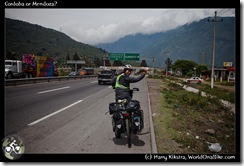 Ivana wanted a picture with the turn-off to Cordoba and Mendoza, both two cities near her province in Argentina and soon after we got the first of several flat tires.
Ivana wanted a picture with the turn-off to Cordoba and Mendoza, both two cities near her province in Argentina and soon after we got the first of several flat tires.
During the downhill Ivana had not managed to avoid al exploded tires and her tires were punctured with several thin but strong parts of steel wire that strengthen the truck tires. Fixing tires on the side of a busy highway is not my favourite thing to do, but there was no other option.
We had lost enough altitude to be in the warmer air of the tropics again. We also got treated to our first heavy tropical rain shower. Actually, when thinking about it, it was the first rain since Central California, USA!
The slope eased, but still we were going down. The view of mighty Pico de Orizaba must be wonderful from this side, but all we could see behind us was a big pile of tropical clouds. We ended our day after 133km, about 4 flat tires and 2500m of downhills in a wet garden next to the highway, with mangos falling from the trees and chickens scaring Ivana.
19/20th June: the long ride to Cancun: World On a Truck
The downhill had ended and we rollercoastered to the junction of the toll roads. Ahead was Veracruz, we turned right towards the east, as we had to get to Cancun with a few days, so we needed some good place for our hitchhiking.
It took about 50km, but we found a gas station where we could ask refuelling pickups for a ride. Then things went fast.
The first ride took us about 200km down the road. We cycled a few minutes to a toll booth and got another ride quickly, which took us 60km. When we left them we noticed a big truck we had seen before. The friendly driver, who had waived at us when he had passed us before, asked us where we were going.
We replied that we were trying to get rides to get North-East.
“I am going to Cancun, want to join?”.
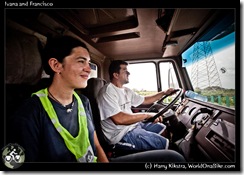 Cancun! It still was about 1100km/700miles away. We introduced ourselves properly to Francisco, a gentle man who runs a moving company from the border with Texas. He has a fleet of about 20 trucks and regularly drives himself as well. His truck was already half empty, with 2 loads left to drop off: one in Merida and one in Cancun!
Cancun! It still was about 1100km/700miles away. We introduced ourselves properly to Francisco, a gentle man who runs a moving company from the border with Texas. He has a fleet of about 20 trucks and regularly drives himself as well. His truck was already half empty, with 2 loads left to drop off: one in Merida and one in Cancun!
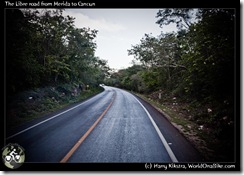 We put our bikes in the back and joined him in the cabin for a long ride to the Yucatan peninsula. After a roadside dinner he parked the truck at a truck-stop and while he slept in the cabin, we slept in the back of the truck, inside the tent against the mosquitoes, but the sweaty heat kept us awake.
We put our bikes in the back and joined him in the cabin for a long ride to the Yucatan peninsula. After a roadside dinner he parked the truck at a truck-stop and while he slept in the cabin, we slept in the back of the truck, inside the tent against the mosquitoes, but the sweaty heat kept us awake.
As the toll roads are too expensive, Francisco took the ‘libres’, meaning extra kilometres and much extra traffic. We slowly passed through the states of Tabasco & Campeche and ended up in Merida. The city is known for it beautiful centre, but we had to unload the possessions of a family that had worked in the US for a while in a less scenic part of town, where the roads were littered with trash.
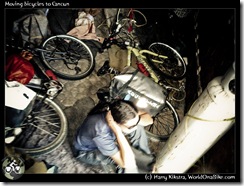 Francisco hired a few guys at the entrance of the city to help us unload in the heat. After getting paid, they bought 6 bottles of beer, which were emptied and thrown out of the window before we could take them back to where we had picked them up.
Francisco hired a few guys at the entrance of the city to help us unload in the heat. After getting paid, they bought 6 bottles of beer, which were emptied and thrown out of the window before we could take them back to where we had picked them up.
It was time to cross the Yucatan state. There is a huge and expensive new quota, so we took the dark and windy libre instead. The road passes through every little town and we had to stop hundreds of times to carefully cross the many ‘topes’, speed bumps.
We arrived late at night but 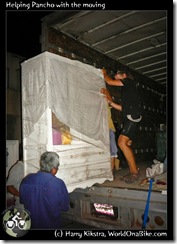 still had one load to deliver before we could find a place to sleep.
still had one load to deliver before we could find a place to sleep.
After we finished 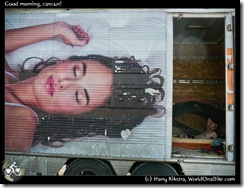 Francisco parked the car in the centre and went to sleep in a friends house, while we erected the tent again, inside the truck.
Francisco parked the car in the centre and went to sleep in a friends house, while we erected the tent again, inside the truck.
We had been rushing the past weeks, but now we had made it to Cancun a week earlier than planned. It took a huge load off our shoulders as we now had some time to check out the city and prepare the visit of our mums.
Cancun
Francisco came back to his truck in the morning, and his friend Daniel invited us to come over and stay in his house. We had friends in Cancun, but as we had arrived so quickly, we had not been able to contact them and gladly accepted Daniel’s offer.
He not only put us up for the night, but also gave us some tours, which helped a lot to understand the city. We visited the touristic places as Francisco had to buy some jewellery for his wife and drank some “raspados”, shaved ice with sweet fruit flavours.
Cancun proper: the beach!
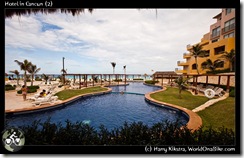 The city were we were is actually not the Cancun that is so famous. The downtown area is where the people live and go for their Sunday dance, the tourists go to a 25km/16mi long peninsula, totally covered with big expensive hotels, clubs and restaurants.
The city were we were is actually not the Cancun that is so famous. The downtown area is where the people live and go for their Sunday dance, the tourists go to a 25km/16mi long peninsula, totally covered with big expensive hotels, clubs and restaurants.
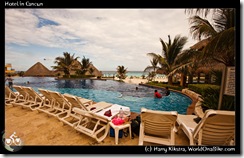 Though all beaches are public and thus open to everybody by law, in practice it is very hard to get to them, as the hotel properties are private and they are all built next to each other.
Though all beaches are public and thus open to everybody by law, in practice it is very hard to get to them, as the hotel properties are private and they are all built next to each other.
Daniel had worked in the hotel business before and took us to see the “Zona Hotelera”. We visited a few of the smaller public beaches, with did have easy access, but we also checked out a large hotel. It was something we will never be able to afford, but it was fun to pretend ![]()
Kowalski! Status report!
All is well. We will park our bikes soon as our mums will arrive and we will be semi-proper tourists for a while. But still there are plenty of things to show, so stay tuned…
Day 338-341, 14-18 June 09: Pico de Orizaba, summit of Mexico
September 20, 2009 by Harry, 2,273 views
Filed under Central Mexico, Mexico, North America, Trip reports
14th June, From Puebla to Tlachichuca: dust devils and up the slopes of the volcano. 52km, about 500m up
After our goodbyes to Hiram’s family, we found our way through the busy streets of Puebla, heading North East to to the exit of the city, the main highway towards Veracruz on the Gulf coast. Our mums would arrive in Cancun, more than 1600km away via busy highways, in 2 weeks and we had to be there several days before to arrange accommodation, trips etc. We needed to make at least 150km per day, either cycling or taking a ride. Still there was one thing left to do, before heading for the Mexican Riviera Maya…
The toll road was busy and noisy as was to be expected and during the day we took 2 rides until we arrived at a slightly less busy road heading North (no!!!). After turning East again, we headed in the direction of a huge pile of clouds. The road looked flat, but in reality it was gently but constantly sloping up. It felt like we were cycling with our brakes stuck, or with a flat tire.
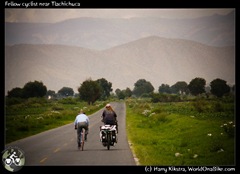 Ivana was just 100m behind when I stopped in a small town to wait for her, but she got right in a path of a dust devil, sweeping through the streets and depositing Madre Tierra all over her. There were dust devils everywhere on the fields and we had to sprint a few times to avoid one.
Ivana was just 100m behind when I stopped in a small town to wait for her, but she got right in a path of a dust devil, sweeping through the streets and depositing Madre Tierra all over her. There were dust devils everywhere on the fields and we had to sprint a few times to avoid one.
At about 2400m altitude we reached our goal for the day: Tlachichuca, a slightly depressing town, with just one real benefit for us: it is the starting pint for ascents of the highest mountain of Mexico: Citlaltepetl, better known as Pico de Orizaba! Depending on the source, it is between 5611 & 5700m (approx 18,700ft) high.
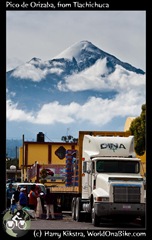 This makes it not only the highest point of Mexico, but also after Denali (Alaska) and Mount Logan (Canada), the 3rd highest peak in North America. It is not a technical climb, merely a long hike, but still crampons and ice-axe are needed as even though it is shrinking rapidly, there is still a glacier on the upper part.
This makes it not only the highest point of Mexico, but also after Denali (Alaska) and Mount Logan (Canada), the 3rd highest peak in North America. It is not a technical climb, merely a long hike, but still crampons and ice-axe are needed as even though it is shrinking rapidly, there is still a glacier on the upper part.
As I have many US clients for my organised 7summits.com expeditions to Kilimanjaro, Aconcagua & Elbrus, the summits of Africa, South America and Europe, it would be nice to offer a climb of Pico de Orizaba as well. It is very close to the US, affordable and a good way to test how you are doing on ice, and at a similar altitude and you can use it as pre-acclimatisation, making the other climbs a lot easier.
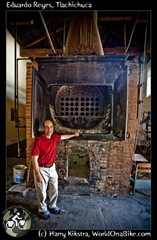 I had gotten in contact with the best-known local organisation, led by the Reyes family. For many generations, this family has been an important factor for the town of Tlachichuca as well as for the exploration of the Pico.
I had gotten in contact with the best-known local organisation, led by the Reyes family. For many generations, this family has been an important factor for the town of Tlachichuca as well as for the exploration of the Pico.
 I met up with Gerardo Reyes, who showed me around their family mansion, a former soap factory, where we spent the night.
I met up with Gerardo Reyes, who showed me around their family mansion, a former soap factory, where we spent the night.
Though he could not arrange a guide at short notice, we arranged that his driver would take us to and from the base camp hut the next day, so I could climb it by myself.
15th June: Tlachichuca – Base camp Pico de Orizaba, 2400m – 4200m (8000-14,000ft)
Gerardo was kind enough to borrow me some climbing gear as I had almost nothing with me besides our camping gear. Ivana had decided that she would not climb the mountain, but she would accompany me in to the base camp for support.
The huge 4wheel drive took us through small mountain towns, through pine forests over a very bumpy sandy road. I had read that sometime people attempt to drive up here in regular cars, but it seemed completely impossible to me. It would make a nice downhill, but only on full suspension bikes; Kowalski would get a heart attack here and maybe even break something.
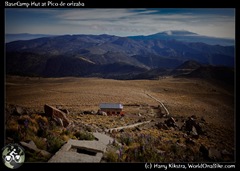 The main climbing season is in winter when the hut is often completely packed with people camping outside as well. Now the hut was totally empty, leaving us to choose from the few dozen wooden spaces. We felt the altitude difference and I only went for short hike up the remains of the old defunct concrete aquaduct before heading down to the cold hut, removing several Coca Cola cans from the trail on the way down.
The main climbing season is in winter when the hut is often completely packed with people camping outside as well. Now the hut was totally empty, leaving us to choose from the few dozen wooden spaces. We felt the altitude difference and I only went for short hike up the remains of the old defunct concrete aquaduct before heading down to the cold hut, removing several Coca Cola cans from the trail on the way down.
The driver had shown us a small source of fresh and clear water and we spent the rest of the afternoon reading, cooking, eating and drinking tea and soups to hydrate well in order to prevent altitude disease.
16th June: Base camp to the glacier: 4200-5100m (14,000-17,000ft)
I woke up early for a hike up the mountain. The route description I had read and heard were very broad and vague and also outdated as the glacier had retreated considerably in recent years. For the climb to the summit I would have to find my route in the dark in order to come safely down during the day time, so today I was going to find my way up to the glacier.
The start was very easy as the concrete remains and the well-beaten path were clear. But then the path split several times forcing me to check several variations before deciding on the best one.
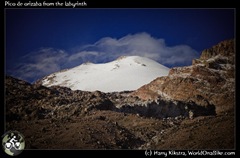 The last section before the glacier had been covered by ice not so many years ago, but now it was a rocky mess. There were little ‘stone men’ and other route pointers everywhere, rendering all of them useless. This section is now called The Labyrinth, as it is easy to loose the way; that is, if you know it in the first place
The last section before the glacier had been covered by ice not so many years ago, but now it was a rocky mess. There were little ‘stone men’ and other route pointers everywhere, rendering all of them useless. This section is now called The Labyrinth, as it is easy to loose the way; that is, if you know it in the first place ![]()
Still it was not to steep and with some scrambling I found a quite straightforward way up to the plateau, where some soft sandy ridged led me to the glacier. It looked sad, more like a thin crusty snowfield than a mighty glacier. I guess that in only a matter of decades, maybe even years, it will be reduced to some scattered snow patches before disappearing forever.
It felt good to be in the mountains again. Even on a relatively easy mountain like the Pico, the fresh air, the views, the excitement, the thin air and the exercise all made me feel very alive as always. It was nice to be the only one on the mountain, the solitude makes the experience stronger.
The strong cold wind and the upcoming clouds reminded me of the force of the mountains and I hid behind some rocks to eat some sandwiches and drink more, staying as long as possible without cooling down too much, to maximise the acclimatisation effects of this reconnaissance trip. Even with searching it had taken less than 3 hours to the glacier, and from here the route would be straightforward to the summit, so I felt good about trying for the next day.
The way down through the cloudy Labyrinth turned out to be difficult to find than the way up. Several times I found myself on top of a steep drop, before the not so obvious, but much easier route down opened itself up for me.
Later that afternoon I heard a car coming and soon we were surprised by 3 new visitors: Anabel, a young climber from Spain, her boyfriend Victor and a local guide named Guadalupe.Victor was not climbing, but Anabel and her guide were going to try for the summit this night as well, so we decided to climb up together for safety and for the company.
17 June 2009: climbing in the dark
We woke up at 01.00, had our breakfast, packed everything and headed into the dark night before 2Am. It was cold outside, but at least the rainy clouds from the day before had disappeared, making way for thousands of stars. We chatted about our climbs and the mountains and time passed quickly. We went slower than I had done the day before, but as Guadalupe knew his way without any hesitation, we made it to the start of the glacier in about the same time as the day before.
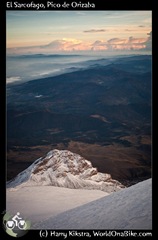 Anabel was feeling the altitude and was slowing down. After we had put on our crampons, Guadalupe tied her to his rope and went first. I followed shortly after, but did not go on the rope. I liked the feeling of climbing alone and it gave me time and space to stop for pictures without bothering anybody.
Anabel was feeling the altitude and was slowing down. After we had put on our crampons, Guadalupe tied her to his rope and went first. I followed shortly after, but did not go on the rope. I liked the feeling of climbing alone and it gave me time and space to stop for pictures without bothering anybody.
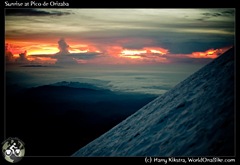 The climb up the glacier was straightforward as expected. We slowly switch-backed our way up, while the sky in the east slowly turned purple, then orange as the sun rose behind the storm clouds of the Gulf coast, showing the mountains, clouds, cities and fields around us.
The climb up the glacier was straightforward as expected. We slowly switch-backed our way up, while the sky in the east slowly turned purple, then orange as the sun rose behind the storm clouds of the Gulf coast, showing the mountains, clouds, cities and fields around us.
 Anabel was almost grinding to a halt and was not sure if she was going to make it, but with encouragement from two sides, she continued slowly but steadily.
Anabel was almost grinding to a halt and was not sure if she was going to make it, but with encouragement from two sides, she continued slowly but steadily.
The shadow of Pico de Orizaba projecting on the fields appeared on our right when the sun made it above the clouds and with the sun came a new energy, pushing us up the glacier to the rocks of the crater rim.
The summit of Mexico!
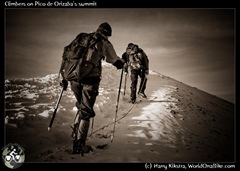 It was almost 07.20 when we walked along the Crater edge to the mangled iron that once was a summit cross.
It was almost 07.20 when we walked along the Crater edge to the mangled iron that once was a summit cross.
Even with the many stops on the glacier, it had taken less than 5.5 hours, which was very good.
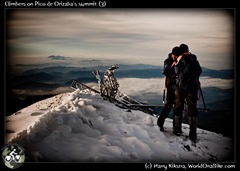 We congratulated each other with being the highest people between Alaska & the Andes.
We congratulated each other with being the highest people between Alaska & the Andes.
The weather was great and we took our time to eat, drink and take plenty of pictures, before heading down the glacier, here is a selection ( click to enlarge, more photos are in the photo section here).
Running down
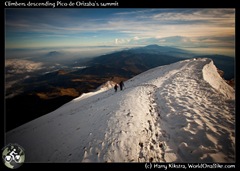 It was a quick walk down, as the snow already was softening and with the thicker air, Anabel’s energy returned. We sped down the rocks and were greeted outside the hut by Ivana & Victor, who were barely awake. They wondered if we had made it as it was only 10 ’o clock!
It was a quick walk down, as the snow already was softening and with the thicker air, Anabel’s energy returned. We sped down the rocks and were greeted outside the hut by Ivana & Victor, who were barely awake. They wondered if we had made it as it was only 10 ’o clock!
The others went down quickly, but we had to await our ride back, that was scheduled for the afternoon. After another bumpy ride down we arrived back at the Reyes mansion, where a warm shower was our reward.
18th June: to the lowlands!
I would not have liked to miss the great days in the mountains, but now we really had to hurry to get to Cancun in time, we had to get moving! We need to get a lot of rides or take a bus, but still there was one more section to cycle that we did not want to miss: downhill ![]()
Kowalski! Status report!
Knees are doing quite ok, and with the upcoming break in Cancun I am positive that we are able to continue cycling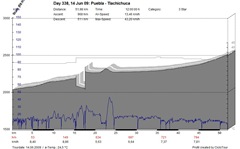 .
.
Here are some figures you might enjoy:
- Distance cycled: 10,241 km (6363 Miles)
- Days on the road since Prudhoe Bay, Alaska: 341
- Days actually cycling (riding days: more than 25km/15miles): 146
- Time really spent cycling (not including stops, waits, lunches etc): 695 hours for Harry, probably 750 or so for Ivana, as she cycles a bit slower.
- Average real riding time on the riding days: 4 hours and 46 minutes per day
- Average speed for Harry since Alaska: 15km/hr or 9.3mi/hr
- Flat tires: we did not really keep count, but I think about 6 for Ivana and about 5 for Harry
Day 336-338, 12-14 June. An impression of beautiful Puebla.
September 18, 2009 by Harry, 2,163 views
Filed under Central Mexico, Mexico, North America, Trip reports
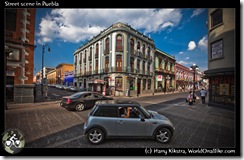 It was less than 10km from Cholula to Puebla and the cities are basically connected. With 1.5 million people the city is huge (3rd largest of the country), but the historic centre has remained largely intact and is very attractive.
It was less than 10km from Cholula to Puebla and the cities are basically connected. With 1.5 million people the city is huge (3rd largest of the country), but the historic centre has remained largely intact and is very attractive.
We had been invited by CouchSurfing host Hiram and his family, who own and run a very popular Mexican restaurant together. Still he had time to do a quick city tour with us and gave us a lot of tips of where to go while he was at work.
 One impressive place he pointed out is the fully gilded Rosary Chapel of the Templo de Santo Domingo, which is so shiny, you almost need sunglasses.
One impressive place he pointed out is the fully gilded Rosary Chapel of the Templo de Santo Domingo, which is so shiny, you almost need sunglasses.
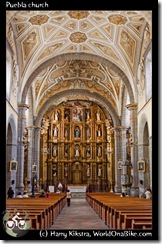 The zocalo or main square is the courtyard of the huge Cathedral, with Mexico’s highest towers. Rich people see it regularly as it appears on the 500 pesos note (about USD$ 40, more value than most Mexicans see in one bank note).
The zocalo or main square is the courtyard of the huge Cathedral, with Mexico’s highest towers. Rich people see it regularly as it appears on the 500 pesos note (about USD$ 40, more value than most Mexicans see in one bank note).
But maybe the best part of Puebla is just strolling around the centre, through colourful streets lined with colonial houses, with patios and balconies.
Tourists and locals are enjoying themselves everywhere on the terraces and restaurants and in the many shops lining the streets.
Fiesta
Puebla has always been a Catholic stronghold and this has resulted in many religious celebrations, many of which have the benefit that a lively street market will take place, just a few blocks away from the zocalo.
We enjoyed the different foods for sale, the fair rides for kids, the artesanias, the music and the general positive atmosphere. Had I said before that everybody should visit Mexico? Just in case I’ll do it now: do not let biased political media scare you away from a wealth of culture, nature, gastronomy and friendliness, visit Mexico.
There, I said it.
Now, I invite you to take a look at some impressions of the market and the city. (Click for a larger version, these and more photos of Puebla are also in the photo section here).
Mexican treats in El Balcon
We arrived back late at ‘El Balcon’, the restaurant of Hiram’s family. Late at night it was still completely packed and several people were waiting outside. No, it is not (yet) in the Lonely Planet as it is (just) 7 blocks away from the centre, but the locals clearly know where to go. Even when they changed locations a while ago, the clients followed for the clear and honest food.
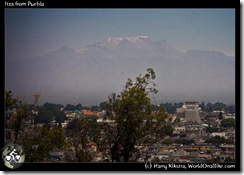 Hiram also took us up the Cerro de Guadeloupe, which is not only the place where the French were defeated on 5th may 1862 (hence all the street names all over Mexico named 5 de Mayo), but on clear days you can also see the silhouette of Izta, the mountain known as the sleeping woman.
Hiram also took us up the Cerro de Guadeloupe, which is not only the place where the French were defeated on 5th may 1862 (hence all the street names all over Mexico named 5 de Mayo), but on clear days you can also see the silhouette of Izta, the mountain known as the sleeping woman.
He introduced us to his friend and fellow CouchSurfer Leandro. We did not have time to visit his place, but had some good discussions about life and saw some more hidden gems of the city together.
Hiram’s parents were worried about our trip and hugged us close and shed some tears when praying for our safe journey. We are not religious ourselves, but the care and love of people that were strangers 3 days before keeps on surprising and warming us. So maybe the prayers do help as we will take care, so we can meet more great people like them and maybe one day return the favour.
Back on the road again..
Fortunately we found the way around the steep hill when we left Puebla, sooner than we would have liked. If we’d hurry, we would maybe have time for one more activity before we really had to get to Cancun.
Our mums were already getting very worried that there would be nobody to pick them up when arriving in 2 weeks. But before we would leave the Mexican highlands to get back down to sea-level, there was one place far from it that I wanted to visit…
More soon ![]()
Day 332-335: 8-11 June: Mexico City-Cholula, canals, interviews, city and volcanoes
September 16, 2009 by Harry, 3,409 views
Filed under Central Mexico, Mexico, North America, Trip reports
Cycling through the outskirts of Metepec was still ok, but when we reached the main road from Toluca to Mexico, we had to use all senses we had to stay alive. We stopped at a gas station 20km out of town, as it was no use to try to cycle into the city any farther. There was a big climb ahead, the toll roads was completely full with cars and the free road even fuller, but then with trucks as well, neither having a decent shoulder for cycling.
We got a ride from a nice guy who worked for a TV station in the city. He took us over the high pass and down to one of the biggest cities in the world: depending on your definition, around 20 million people live in the valley!
 He dropped us off at his office, conveniently situated near the ‘periferico’, the huge highway, circling all around the centre of Mexico City. We were on our way to Ulises, yet another CouchSurfing host. According to the map, it was only about 10km to his house.
He dropped us off at his office, conveniently situated near the ‘periferico’, the huge highway, circling all around the centre of Mexico City. We were on our way to Ulises, yet another CouchSurfing host. According to the map, it was only about 10km to his house.
The periferico was the logical and fastest way, but filled with fast traffic as well, which we were not. Luckily, there was another road right beside it, with traffic lights and less hurry. As we still had some leftover free miles, we made it to Ulises’ area quickly, only interrupted by a taxi strike that had blocked some roads. Just after passing the blocked area, a TV reporter on a motorcycle did a quick interview with us, right on the street, not sure if it made it to the evening news.
We made it safely to Ulises’ house, but could have had some serious trouble as several metal drain covers were missing on the road, exposing holes without visible bottom, and 60cm/2ft across.
Ulises and his family welcomed us with open arms and treated us to some more Mexican dishes. Forget about Taco Bell, if you love real food (duh), you need to visit Mexico sometimes, as every region has its own different tasty specialties.
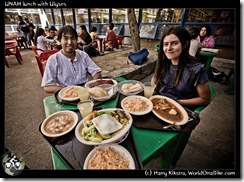 Ulises is studying engineering, specializing in the movements of the earth underneath the large buildings in the historic centre. he could as well been a professional guide if he wanted, as he shared his encyclopaedic knowledge about the culture and history of the City.
Ulises is studying engineering, specializing in the movements of the earth underneath the large buildings in the historic centre. he could as well been a professional guide if he wanted, as he shared his encyclopaedic knowledge about the culture and history of the City.
It was a shame that we had to rush, as there are many things to see in the city, that actually consists of many smaller towns and neighbourhoods, all absorbed into the giant metropolis, but with their own character and attractions.
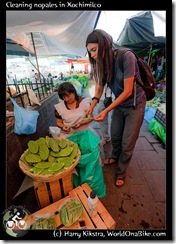 We ate a great and cheap lunch at the huge UNAM University complex, actually a city in itself, where the future of Mexico is being shaped. In the afternoon we visited the market and historic centre of Xochimilco, in the South part of the city.
We ate a great and cheap lunch at the huge UNAM University complex, actually a city in itself, where the future of Mexico is being shaped. In the afternoon we visited the market and historic centre of Xochimilco, in the South part of the city.
Ivana took a quick lesson how to prepare the nopales, the flat cactus leaves that is a popular vegetable. We relaxed and took a Gondola tour through the ancient canals that are still open and of course enjoyed more paletas and drank a ‘pulque, the ancient fermented drink that is still popular.
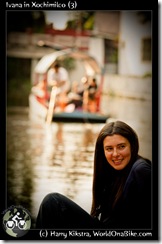 For about USD $10 you get a private boat for an hour, complete with a gondolier slowly pushing the boat through canals lined with nice houses & lush green trees.
For about USD $10 you get a private boat for an hour, complete with a gondolier slowly pushing the boat through canals lined with nice houses & lush green trees.
It was low season and not busy, but besides a few other boats with tourists, there are usually also boats selling food, drinks and souvenirs, and even some Mariachi boats with a complete orchestra that will play a song for a small charge. There are party boats where the youth come to drink and dance and complete families have reunions and a good and relaxed time, while floating slowly on the ancient waters.
You would have no idea that you are in one of the largest cities in the world, that was completely shut down a few weeks before because of fear for the ‘swineflu’.
Life in the city
There are enough sights, museums and monuments to keep you busy for weeks, if not months in Mexico City. The centre is well-known, the main square (where photographer Spencer Tunick once captured a record 18,000 nude people, a shock to the Catholic country) with the nearby ruins, government buildings, huge flag and the grand cathedral. As we had little time to do the city justice, we opted to see some of the lesser known pretty places where people actually live and work. There are parks, a small Chinatown, many big office buildings and all kinds of museums and interesting buildings.
We walked and rode the bus and the infamous subway between all of them and noticed that:
- nobody was wearing the mouth covers we saw in the news, just some people serving in restaurants &
- we did not get robbed, pick pocketed, kidnapped or molested once, how weird is that!
In the evening we visited some older towns that had been swallowed by the city. Friendly Tlalpan was as quiet as any small country town and beautiful Coyoacan should be one of the Pueblos Magicos, as pretty and relaxed as it is. Nope, again, no robberies and the air was clean.
10th June 2009: Interview and into thin air!
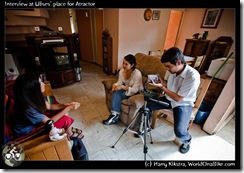 The next morning we were interviewed by some nice guys, for a new online magazine, called Atractor; the interview can be seen online here.
The next morning we were interviewed by some nice guys, for a new online magazine, called Atractor; the interview can be seen online here.
We had told Ulises that we wanted to see the Paso de Cortez, the famous mountain pass between the mountains Izta & Popo, where Cortez made his way to the valley. Ulises advised against cycling out of the city and as he loved the place, he offered to bring us there with his small car. 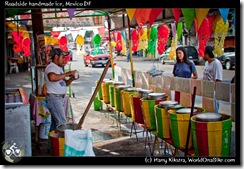
After lunch (Chicken with green mole!) we loaded our bikes on the bike rack, just fit all the bags inside and headed out the city. We stopped at one of the many handmade ice-cream stalls and continued up and over several nice little towns, situated on grassy fields.
The actual road up to the pass was steep, but paved and even though it rained, we slowly rose above most of the clouds, feeling happy we were not cycling/pushing our bikes through the rainy forest. The pass and a visitor centre are at about 3500m/12,000ft altitude, but the huts and camping spaces are higher.
We continued on a slippery and rocky unpaved road and made it all the way up to a large hut. It seemed deserted, but after knocking repeatedly, the guardian Miguel opened up and let us in. We had brought our tent, but for a few pesos, we could stay in the cozy hut, so we opted for that instead, enjoying the sunset behind Popocatepetl (‘Popo’), with 5452m/18,000ft the 2nd highest mountain of Mexico.
Miguel enjoys living between the mountains and had taken thousands of pictures of the mountains and the wildlife on it and showed us many great ones on his laptop, while we ate some snacks together for dinner.
Popo, the warrior and Izta, the sleeping woman
Popo can no longer be climbed, as it is still very active and the constant fumes are lethal. Popocatepetl means ‘smoking mountain’ and only 4 years ago a large eruption shot 5km into the air keeping 30 million people that will be impacted by a larger blast awake…
Iztacihuatl (‘Izta’) on the North side of the pass and with 5220m only a few hundred meters lower, is dormant and still climbable, though the glaciers are shrinking. We did not have any glacier gear so just stuck to enjoying the magnificent mountains from the pass.
There are a lot of variations on the legend of Popo & Izta. Basically warrior Popo was in love with Izta, but was told by her parents that she had died when he was in battle. Izta was told the same about Popo and died of grief. Popo returned to find his loved one dead and laid her on the land, while resting sadly besides her.
This is why Iztacihuatl is known as ‘The Sleeping Lady’, as on clear days after snow, the mountain scarily resembles a woman lying down on her back, with the classic Volcanoe-shaped Popo at her feet. The several summits are known as the Knees, the Head and the breast.
The next morning we woke up early to see the sunrise with Miguel. It was cloudy, but far away we could see the perfect shape of the summit of Pico de Orizaba, the highest mountain of Mexico (and 3rd of North America, after Denali & Mount Logan). As to salute the sun, Popo shot a small eruption into the multicoloured sky.
We love seeing the cities and how the people live in faraway countries, but natural shows like these always impress more than anything else…
.
To protect the bike as well as the car, we mountain-biked down to the pass while Ulises drove the car with the luggage down. We loaded our bikes up at the pass and said our goodbyes and thank-you’s to Ulises who had helped us out so much.
The east side of the Paso de Cortez is unpaved but the first few kilometres the smooth volcanic road was gentle enough. However, once we entered the forest again the road became horrible, slowing us down to protect the bikes, luggage and our spines. Big rocks were on the road and it was impossible to go fast, even though it was so steep we had to brake constantly. This lasted an hour or so, and if you ever are thinking about it: do NOT try to cycle up this side unless you are a professional mountainbiker without luggage…
We had lost a lot of altitude, but luckily there were a few free miles left when we hit the pavement and we zoomed through the fields towards Cholula. Usually we aim for the church if we want a place to have lunch as usually the Catholics have claimed the best and culturally richest parts of all Latin cities and normally the places are very beautiful.
In Cholula we had to search a bit for the pretty zocalo as Conquistador Cortes had almost 40 churches built after taking the city, but we ended up in the park, eating and relaxing from the downhill, only disturbed by a series of processions that came with terrible music and loud bomba’s, very noisy explosives shot into the air.
We had aimed to get to Puebla but stayed in Cholula that night with another CouchSurfer that offered a last-minute couch. We almost passed the giant Piramida Tepanapa, unnoticed as it is so big and covered with grass, that it looks like a huge hill. As often, there is a Catholic Church built on top, but they also might not have known that there was the largest pyramid on earth underneath.
Cholula is nowadays connected with Puebla, but in order to see more of the latter, we decided to move to Puebla, to see the often acclaimed city with our own eyes… We still had to rush, but my feet had started itching when I had seen the highest mountain in Mexico from afar… Would there maybe be time to… ? Tune back in to WorldOnaBike next time ![]()
Kowalski! Status report!
- Our bikes survived the downhill, though Ivana got a flat tire on the sharp rocks there.
- Knees and back are ok, but we are getting a bit nervous as we have to be in Cancun within 2 weeks…
- Total km cycled (excluding rides): 10,370 (about 6500 miles)
- More pictures of Xochimilco and Popocatepetl can be found on the picture page: http://worldonabike.com/photos . as always, larger versions of the images appear automagically when clicking on the small versions (when reading this on http://WorldOnaBike.com). Try it!
Day 325-331, 1-7 June 2009: highland magic in Morelia
September 14, 2009 by Harry, 3,006 views
Filed under Central Mexico, Mexico, North America, Tips & Tricks, Trip reports
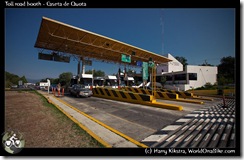 We were dropped off in the morning at our favourite pick-up spot: the tollbooth of the quota. For once we were not the only persons there without a car, as a demonstration of angry teachers was about to commence.
We were dropped off in the morning at our favourite pick-up spot: the tollbooth of the quota. For once we were not the only persons there without a car, as a demonstration of angry teachers was about to commence.
 The toll roads in Mexico are very expensive, most truck drivers and definitely the underpaid teachers cannot afford to use them, so they were going to occupy the booths and let everybody go free as a protest.
The toll roads in Mexico are very expensive, most truck drivers and definitely the underpaid teachers cannot afford to use them, so they were going to occupy the booths and let everybody go free as a protest.
Unfortunately the guy that Ivana asked to give us a ride to Morelia had already paid. When he stopped to load our bikes in the back of the truck, he noticed the few dozen of people waiting and carefully asked ‘How many people need a ride again?’ ![]()
 We had not expected to get to Morelia so soon, but it was nice to have some time to cycle through the old city. Morelia is one of the reasons people should visit Mexico: it has a wonderful historic centre, full of culture and with loads of buildings that are older than anything in the US. The university city is full of young people and there are plenty nice places to eat, drink or party if needed.
We had not expected to get to Morelia so soon, but it was nice to have some time to cycle through the old city. Morelia is one of the reasons people should visit Mexico: it has a wonderful historic centre, full of culture and with loads of buildings that are older than anything in the US. The university city is full of young people and there are plenty nice places to eat, drink or party if needed.
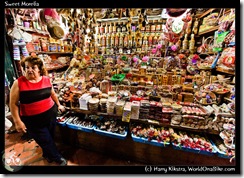 We had been invited by our new CouchSurfing friend Monica to stay with her family, we were already the 3rd cycling couple they had hosted. Monica and her family took great care of us and we stayed much longer than planned. We still had a deadline to meet, but the generosity of Monica, her mother Yolanda, father Juan and brother Juan Pablo kept us relaxed.
We had been invited by our new CouchSurfing friend Monica to stay with her family, we were already the 3rd cycling couple they had hosted. Monica and her family took great care of us and we stayed much longer than planned. We still had a deadline to meet, but the generosity of Monica, her mother Yolanda, father Juan and brother Juan Pablo kept us relaxed.
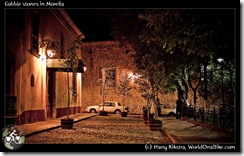 Yolanda is not just a great conversationalist with a lot of knowledge about history, culture and politics, but also a great cook. She surprised us every day with new local dishes, made with fresh and tasty natural ingredients only.
Yolanda is not just a great conversationalist with a lot of knowledge about history, culture and politics, but also a great cook. She surprised us every day with new local dishes, made with fresh and tasty natural ingredients only.
A welcome relief from the fast-food stores that are popping up everywhere in Mexico and from the pre-processed chemical packages that are sold as ‘food’ in the many small supermarkets. She even gives free classes about nutrition in schools and every meal was a feast.
We got to rest and recover from the hot Mexican coast My cut healed well and left only a small scar in the shape of a ‘7’, which is actually pretty cool ![]()
Patzcuaro, the magic town
When we mentioned that we would have to leave soon, they said that we could not go without seeing Patzcuaro, and they took us to this historic town between Uruapan & Morelia: one of the few dozen ‘Pueblos Magicos’, a list of less than 30 ‘magical cities’ of Mexico. Places that give you that special feeling…
We enjoyed the lake, ate real quesadillas on the market, had handmade ice-cream at the main square and admired the historic buildings and culture. Many local artists are producing and selling their artesanias on the streets and in little shops around town.
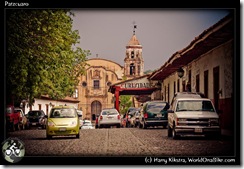
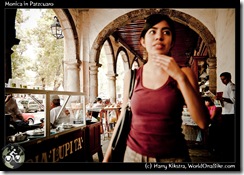
.
As in more historic places in Mexico it is illegal to have big loud advertising in the centre. All shops have the same colours and use the same fonts to advertise their name outside, which secures a wonderful low-key relaxed feeling.
So even though Burger King might have infiltrated in the main square commercial zone, you won’t know it is there until you are almost inside. But why eat there anyway, when there are delicious huge quesedillas for USD$0,50 and tons of unknown but cheap and tasty fruits instead?
Goodbye to Morelia
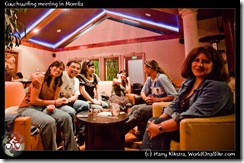 Monica had already taken us a few times to some nice dinners and walks in the historic centre of Morelia and even organised a CouchSurfing meeting for us.
Monica had already taken us a few times to some nice dinners and walks in the historic centre of Morelia and even organised a CouchSurfing meeting for us. 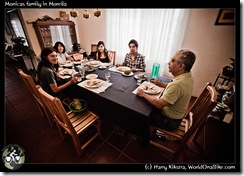
It was hard to say goodbye to this generous family, as many times before we felt we had taken more than we could give in return. We felt privileged to be a part of the family for while and to see yet another side of the diverse Mexican culture.
Back on the road again, heading for DF. Paletas & hills.
If you are in another country and you are heading for ‘Mexico’, you are heading for the country. Once you are there and you are still heading for ‘Mexico’, everybody knows you are going to the capital with the same name. I must admit that I knew nothing much more about Mexico City than that it is one of the largest cities in the world, with accompanying pollution and crimes. Recently, it was known as the ‘Swine flu capital’, though all news sources in Mexico report that the flu originated in the US, so who should you believe?
Anyway, as we always like to see things for ourselves rather than trusting media copycats, we decided that we should at least try to visit the Capital.
Monica & Yolanda guided us out of Morelia and pointed us to the new toll road. Unfortunately the arrogant boss of the accompanying complex would not let us cycle, nor leave us waiting for a ride. All the guards said that once the chief would be away, we would be fine. In the end we managed to ask for a ride and get our bikes loaded on a truck while the driver was paying his toll.
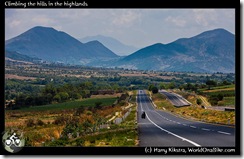 The car dropped us off at Zinepecuaro, where we enjoyed the first of many ‘paletas’, locally made ice-lollies made with big chunks of pure fruit, like Guanabana, coconut, pineapple or my favourite, mango with chile: cold, sweet and spicy!
The car dropped us off at Zinepecuaro, where we enjoyed the first of many ‘paletas’, locally made ice-lollies made with big chunks of pure fruit, like Guanabana, coconut, pineapple or my favourite, mango with chile: cold, sweet and spicy!
A steep road headed up to the main toll road between Guadelajara & Mexico city. The toll booth attendant did not even see us when we sneaked past. We could try to catch a ride here, but decided that we try some highland cycling instead. We regretted that soon as the next 15km was constant and very steep uphill. 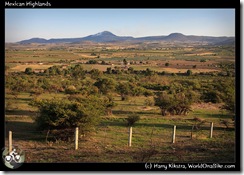
Even though we were at about 2400m/8000ft, it was hot and we had run out of water on the long climb. At the summit we got a bag full of sweet strawberries from a street vendor, which we enjoyed between the pine forests of the highlands.
After an initial downhill there was another smaller hill to climb but then we could enjoy our well-earned ‘free miles’, all the way down to the city of Maravatio. We cycled into town and saw the sign of the Cruz Roja, the red Cross.
If you are ever cycling in a town and have no idea where to stay safely and cheaply, here are some recommended choices, in no particular order, but generally valid all over the world:
- The fire station (Bomberos in Latin America). They usually have nothing much to do and enjoy the company, usually have some extra rooms or at least a safe place to camp
- The Red Cross: same as the Bomberos, + benefit of providing medical help if needed
- The Police: even though sometimes they have a bad name, generally speaking it is a lot safer to stay between police men than between the thieves they are trying to catch

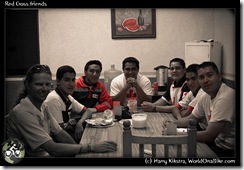 We got some water from the friendly nurses at the Cruz Roja and cooked our spaghetti outside the main entrance. Just after had put up our tent, the team leader cam out and offered us to stay inside instead and use the WiFi as well, which was of course gladly accepted.
We got some water from the friendly nurses at the Cruz Roja and cooked our spaghetti outside the main entrance. Just after had put up our tent, the team leader cam out and offered us to stay inside instead and use the WiFi as well, which was of course gladly accepted.
It was nice to see young (most were between 16 & 20) volunteers, trying to help out in the community, while being educated.
The following day we still had some free miles saved and the kilometres passed quickly through gentle hills and green fields passing over small towns.
It was still a long way to the City and so we stopped at the next tollbooth, where we got a ride fairly quickly. Fortunately we passed the busy madness of Toluca city, and got dropped off right in Metepec, where Monica’s aunt & uncle live.
When we cycled to the charming main square to call them for directions, a group of young cyclists came up and started asking questions about our trip. They were really interested and also used the opportunity to practice their English. They guided us through the small streets, stopping cars to let us pass easily and even called Monica’s family when needed. It was great to have such a young and enthusiastic cycling escort!
We were received with open arms by Laura & Roberto and their son Beto in their house outside of town. To the west we could see the impressive massif of Volcan de Toluca, to the east were the high mountains separating us from one of the largest urban zones in the world, currently feared by the world because of some strange virus… Mexico City, here we come!
Day 322-324, 29-31 May 2009: Hospitals, drunk rides and beach camps
September 12, 2009 by Harry, 3,481 views
Filed under Central Mexico, Mexico, North America, Tips & Tricks, Trip reports
29th May 2009: Boca de Apisa – Maruata: 30km cycling, 2 rides, 3 hospitals, free breakfast, lunch and campsite on the beach
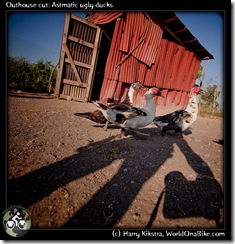 Ivana has a problem with birds. When they fly far away or sing cheerfully in the morning, she loves them, but when they get within her personal space they scare her. So when she had to go to the outhouse, where not only a toilet, but also half a dozen very ugly asthmatic ducks were to be found, she called in the troops.
Ivana has a problem with birds. When they fly far away or sing cheerfully in the morning, she loves them, but when they get within her personal space they scare her. So when she had to go to the outhouse, where not only a toilet, but also half a dozen very ugly asthmatic ducks were to be found, she called in the troops.
To chase the ducks away I walked around the toilet, but suddenly the rotten wood bottom gave away.
I did not know how deep the hole was nor what I would find inside, but as gross scenes from Slumdog Millionaire flashed through my mind, I instinctively held on to the side of the outhouse. 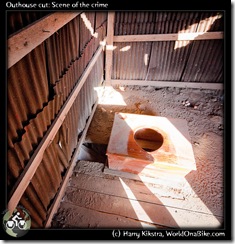
Unfortunately whomever build this construction had decided at some point that it would be better to use nails that are too long, rather than not long enough and my arm got stuck on the end of a nice long and rusty one. As I was still gravity-assisted and going down, it ripped my skin open, holding on to a few cm (1”).
While the bleeding slowly started I walked back out towards Ivana and told her I had cut my arm. The farmer had just come in as well and told us that the army checkpoint on the nearby road had a small hospital, so off we went.
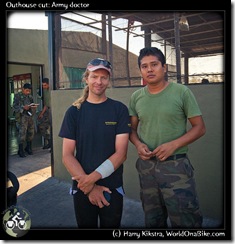 The Army doctor took a look and took me outside to clean the wound thoroughly with a healthy dose of pure stinging alcohol and a lot of pressure. As a small part of the skin was missing, he said that stitches probably would not work. He covered it with bandages, gave me some antibiotics and recommended to get a tetanus injection soon. Next patient please.
The Army doctor took a look and took me outside to clean the wound thoroughly with a healthy dose of pure stinging alcohol and a lot of pressure. As a small part of the skin was missing, he said that stitches probably would not work. He covered it with bandages, gave me some antibiotics and recommended to get a tetanus injection soon. Next patient please.
His fellow soldiers –they check cars and trucks for weapons and drugs- were interested in our trip and when we came back after packing our bikes they invited us for breakfast. We had had our breakfast half an hour before, but a real Bike Traveller never declines food.
We got some tortillas and beans, some meat and fresh juice, served with some nice chats about their work and our trip. To top it off they brought in a chilled guanabana, a large fruit with white flesh that was incredible tasty.
Even though I had some tetanus shots over a year ago in Argentina, a rusty nail in an duck-filled outhouse appeared to me the ultimate test that I did not want to fail, so it seemed like a wise idea to get another shot; there should be a hospital in the small village down the road.
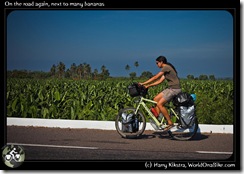 The village turned out to be quite big, noisy and polluted and off the road, but with some help we found the hospital, where I was given the tetanus shot right away. Back to the road again, through a nice flat section lined with banana trees.
The village turned out to be quite big, noisy and polluted and off the road, but with some help we found the hospital, where I was given the tetanus shot right away. Back to the road again, through a nice flat section lined with banana trees.
The next section was not just very hilly, but also known for its bandits and drug-traffickers, who use the small beaches on the rugged coasts to land their smuggling boats. We had planned to get a ride through this section as all the mafia apparently had attracted road-side robbers, attacking vehicles on the quiet road.
First we had to find a good place to hail a pick-up for a ride:
- The perfect spot is near a ‘tope (toh-pay)’, the annoying bumps that are placed on the road to slow down traffic. Cars have to almost stop here and it is easy to ask for a ride.
- If you are on a Quota/toll road, then the toll-both is perfect as well, assuming the guards let you stand there to ask.
- Near a corner, as most (not all) vehicles slow down in a curve, and we can see in time if it is a car or a full pick-up truck as it is no use to stop a car or a pick-up without space for our bikes.
- With sufficient open space for our bikes to be parked near the road and for the car to brake and pull-out.
- Not in a zone known for carjacking, drug trafficking & highway robbers as hitchhikers will be considered possibly dangerous and the cars offering a ride might be as well.
None of the above were available and while looking for them, the road started climbing without mercy. My arm hurt a lot when pulling at the handlebars at steep sections as there was tension on the fresh wound. Ivana’s knee was hurting again as well, so we just started asking passing cars while pushing our bikes up the steep slopes.
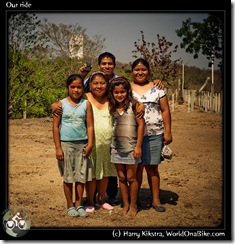 To our surprise a young girl, alone in a big pick-up, stopped and took us and our bikes. We picked her brother up on the way and they took us to their house, where their mum immediately invited us for lunch, treating us to quesadillas and avocado, yum!
To our surprise a young girl, alone in a big pick-up, stopped and took us and our bikes. We picked her brother up on the way and they took us to their house, where their mum immediately invited us for lunch, treating us to quesadillas and avocado, yum!
We could have camped with them, but wanted to get a bit further, so we headed back to the main road and pointed our thumbs towards the sky near a small road-shop.
After several hours of trying, alternating turns in the hot sun, a car truck stopped that could take us to Maruata, which sounded fine to us. What was less fine was that several cases of beer were emptied during the trip and while the road was curvy and bumpy, the speed picked up considerably.
We were sitting in the back with our bikes and were relieved when we arrived near the small town. The first thing we noticed was a huge new building, that turned out to be a newly-opened hospital. Perfect timing, as I wanted to change my bandages and check if my cut had not been infected. We walked in the near-empty building. It was dark as the night-nurses did not know yet where the main light switches were.
A friendly nurse cut away the bandages, took an interested glance at the nasty-but-not-infected-looking wound and then started scrubbing it with half a bottle of iodine using all of her force, suddenly looking a lot less charming.
While I was painfully getting cleaner than the brand new hospital floor, a 14 year old girl walked in crying, fully pregnant and about to deliver. We both looked at her and her crazy mother (or grandmother?) that just laughed like nothing was wrong in this picture. Again I realized the luxury that my so-called ‘problems’ would almost always be smaller than those seen around me.
When checking the prescription the doctor had written out for me, we noticed it was the same as the antibiotics we already had and so we left the 3rd hospital today without paying anything. All the treatments including the tetanus injection had been free of charge. Not just for me as a lucky tourist, but for everybody. Only if I had wanted to buy medication, I would have had to pay. How is that for a ‘developing country’?
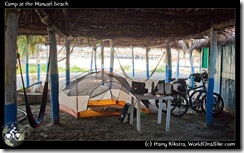 We cycled safely through the dark towards the beach on a bumpy trail, thanks to our headlights on our Santos bikes. Maruata beach is actually quite famous; for the surf and the turtles and it is simply pretty.
We cycled safely through the dark towards the beach on a bumpy trail, thanks to our headlights on our Santos bikes. Maruata beach is actually quite famous; for the surf and the turtles and it is simply pretty.
Now it was dark, but a few guesthouses and restaurants offered some light as well as some food and free camping. A couple of friendly salesmen that also had stopped here for the night offered to pay a room for us, but we explained that we rather be outside in our tent, as it would be cooler and without mosquitoes.
We fell asleep while the surf provided a lazy rhythm to the lightshows of the fireflies. Wat een dag!
30 May 2009: Maruata beach – Caleta de Campo: crazy hills, drunk rides and more beach
Our friendly host suddenly requested money for the free camping after all, but gave in after a brief protest from our side. We headed back up to the road and started cycling, again looking for a great place for our next ride.
There was none. This section of road was insane, a succession of incredibly steep climbs, directly followed by deadly downhills through blind corners on a narrow road with temperatures going through the roof. Rinse and repeat several dozen times. We now realized why the distance on the map had seemed wrong, but was right after all: if you could take this road and stretch it out, it would cover the true distance at least twice.
It would destroy the knees of Lance Armstrong, if he were able to get a fully loaded bike up here. So likely it would ruin ours as well and as the doctor had ordered rest for my arm we resorted to stopping pick-ups to force our next ride through this overheated madness.
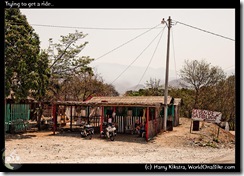 IOf course few people use this road for long-distance and it would take 5 separate rides that day before we would get to our next stop: one friendly guy, a drunk couple that picked us up twice, a trio of young girls in an expensive new truck and a nice man that turned out to be a drunk idiot as well, tossing out an empty beer can out the window every few minutes.
IOf course few people use this road for long-distance and it would take 5 separate rides that day before we would get to our next stop: one friendly guy, a drunk couple that picked us up twice, a trio of young girls in an expensive new truck and a nice man that turned out to be a drunk idiot as well, tossing out an empty beer can out the window every few minutes.
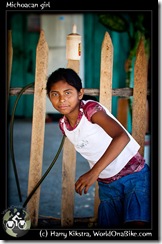 We still managed to cycle about 50km ourselves that day and even spend our lunchtime waiting several hours for a ride at a small place in the middle of nowhere where small kids were cycling downhill on a bike without brakes without wearing shoes, for fun.
We still managed to cycle about 50km ourselves that day and even spend our lunchtime waiting several hours for a ride at a small place in the middle of nowhere where small kids were cycling downhill on a bike without brakes without wearing shoes, for fun.
There we also got to chat with Orlando, an 80-year old Mexican that had great knowledge about geography and mountains all over the world. He was clearly very well educated, but now he just waited in the shade for his next customers: in exchange for free food and lodging, he sold gasoline for a local lady. Using his mouth and a hose he transferred the fuel into the expensive cars that stopped by, realizing that fuel stations were a rarity on this road.
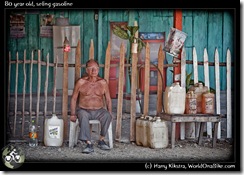 We saw his eyes gleam when we told him about our trip, but our heart broke every time he spent minutes coughing and spitting after every filling-up of yet another car filled with rude people. It was a sad sight, especially with the wrongly spelled ‘Cevende Gasolina’ sign on the road behind him (‘Se vende Gasolina = Gas for sale).
We saw his eyes gleam when we told him about our trip, but our heart broke every time he spent minutes coughing and spitting after every filling-up of yet another car filled with rude people. It was a sad sight, especially with the wrongly spelled ‘Cevende Gasolina’ sign on the road behind him (‘Se vende Gasolina = Gas for sale).
The last drunk ride had dropped us off in a beach town and a steep but paved road dropped us right onto the beach. Ivana was exhausted so I went to check the places to camp. 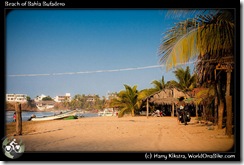 All the restaurants wanted cash to camp on their empty properties, even if we would buy dinner there. In the end the only place that would let us camp, was one that had the kitchen closed.
All the restaurants wanted cash to camp on their empty properties, even if we would buy dinner there. In the end the only place that would let us camp, was one that had the kitchen closed.
So we settled for a few emergency noodle soups and bought some cold beers to thank our hosts and quench our thirst Next door a children’s party hit a piñata (as well as one unfortunate small guest) to smithereens while thousands of small to medium-sized crabs that had appeared out of nowhere crawled around my feet, headed for the ocean. World On a bike in Mexico…
31 May 2009: Caleta de Campo beach – Uruapan: 80km + 200km in rides, up to the highlands!
The road had turned sane again and as our injuries felt better, we decided to make some more miles by ourselves again. The coastal road was a lot nicer here, with a fresh breeze coming up from the pretty beaches and hills that were doable for mortals.
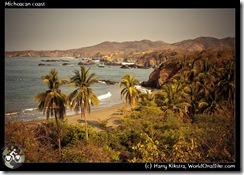 We did try to use ‘lunch’ -the hottest time of the day- for getting another ride as we were now less than one month away from our deadline in Cancun, so all bits would help.
We did try to use ‘lunch’ -the hottest time of the day- for getting another ride as we were now less than one month away from our deadline in Cancun, so all bits would help.
The small town was full of pick-ups, but it turned out that was just for the local fiesta, which in itself turned out to be a cockfight, illegal in the USA, a quite regular Sunday outing in Mexico.
Ivana talked to and helped some local kids that were trying to inflate a bicycle tire. Soon after they came up to me with their broken derailleur and a handful of parts. Though it had been a while since I fixed a derailleur as our Rohloff system has internal gears instead, I managed to turn into Bicycle Repairman and got all the parts connected and the gears going again.
I noticed that the initial joy on the little guy’s face had suddenly disappeared.
‘Comocuantovaser?’, he spoke swiftly but softly with a worried look on his face.
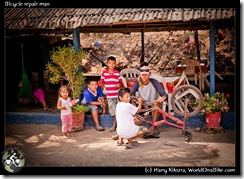 Como cuanto va ser, or ‘how much is it going to be?’, we translated. Poor guy, he was afraid that the gringo would charge him a lot for fixing his bike.
Como cuanto va ser, or ‘how much is it going to be?’, we translated. Poor guy, he was afraid that the gringo would charge him a lot for fixing his bike.
I explained him that it was free and that cyclists should always help each other out when needed and his face cleared up to reveal a bright smile.
Closer to the larger city of Lazaro Cardenas we got 2 short rides across the busiest sections and they dropped us off at the new ‘quota’, the toll road that was not on our 2 maps. We cycled some more along the road, assuming we would at some point encounter a tollbooth.
We noticed that there was almost no trash near the road, a clear sign that it was just opened recently, as all other roads in Mexico are lined with plastic, glass, paper, more plastic and styrofoam. As friendly as the Mexicans are, their own environment is one thing they do not seem to care about. When cycling you really see the extent of the influence of plastic waterbottles & chips: free roadside marketing that shows that thousands of Coca-Cola drinkers have no respect for nature, not even their own.
When we finally got to the crossing where the booth was, some soldiers advised us not to go further east, but inland instead to visit Morelia and to enjoy the cooler air. We looked at our map and decided that it might be a good idea to head for the fresh highlands instead of following the bumpy hot coastline to Acapulco first.
The first pick-up Ivana asked already had some bags in the back, but still agreed to take us all the way to Uruapan. And so within minutes we speeded up on a brand-new road through the steep hills of the highlands, ending up nearly 1800m higher in the fresh world capital of avocado’s.
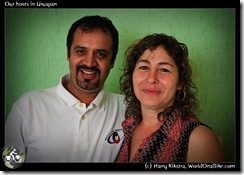 The driver and his wife had planned to drop us off near a gas station, but intrigued by our little business-card they decided to invite us in their house instead.
The driver and his wife had planned to drop us off near a gas station, but intrigued by our little business-card they decided to invite us in their house instead.
We had a pleasant evening with the family Mendez. Again we ended up staying freshly showered and well-fed in the clean beds of new friends, wondering what the highlands of Central Mexico had in store for us…
Day 317-321, 24-28 May 2009: hot hilly roads, tropical fruits and friendly Mexicans
September 10, 2009 by Harry, 2,350 views
Filed under Central Mexico, Mexico, North America, Trip reports
After our trip across the Sea of Cortez it was time to cross terra firma again. Only we were still not sure which route to take. It was clear that we would never make it in time to Cancun, to meet our mums, so what to do? 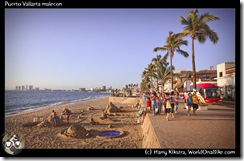
We decided to visit Puerto Vallarta first, as we could not believe that that such a famous place (The Love Boat!) would be nothing more than a collection of ugly resorts and polluted highways.
Our persistence paid off when we cycled over the cobbled streets of old Vallarta and onto the nice Malecon, the boardwalk. There were plenty of people about, artists, friendly beggars, loads of tourists, sand sculptors and even a set of oriental rope artists circling down from their platform.
 It was all nice, but it was also getting dark and we had no idea
It was all nice, but it was also getting dark and we had no idea
- where to go to, from Vallarta,
- where to sleep…
- and, most alarming of all: we did not have dinner yet!
As usual the solution to all questions presented itself without too much effort from our side. Just when we were checking our map of Central Mexico, a couple sat down next to us and asked about our bikes and trip.
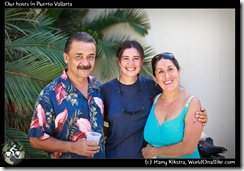 When I asked them in return about the different route possibilities – there is no straight way inland, you can go North and then East through Guadalajara, or South along the coast and then North again- they were sure that the coastal route was the best option: flat, narrow but quiet and only a few sections with drug-traffickers and other accompanying bandits. Sweet.
When I asked them in return about the different route possibilities – there is no straight way inland, you can go North and then East through Guadalajara, or South along the coast and then North again- they were sure that the coastal route was the best option: flat, narrow but quiet and only a few sections with drug-traffickers and other accompanying bandits. Sweet.
Cool, number 1 solved, and number 2 & 3 followed smoothly when they invited us for dinner and to stay in their house near the Malecon. Mexico is so full of friendly people, it looks like a complete different country than the media makes it out to be. Actually it is. Much, much better, as was and would be proven time and time again.
Day 317, 24 may 09: Puerto Vallarta – Near Tomatlan: 74km. Jungle to desert…
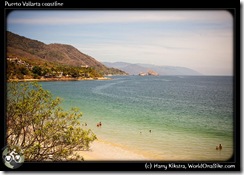 The next morning we were treated to nice tropical fruits for breakfast, pineapple and papaya! Real vitamins!
The next morning we were treated to nice tropical fruits for breakfast, pineapple and papaya! Real vitamins!
It was early but hot, but the coastal route was quite shady and showed us the hidden gems of the Vallarta Bay: nice beaches, amazing mansions and boutique hotels and lush jungle and fruit trees. 180 degrees difference from the dry desert of Baja California and even the rollercoaster road could not spoil our joy.
 That is, until the road turned sharply and went both inwards as upwards. The cool sea-breeze dropped and the temperature rose 10+ degrees within minutes, the jungle turned to desert and the road into a narrow steep wall with little space for our bikes. Our map showed that this would continue to 750m (2500ft) up, which did not seem like a great idea for our knees and general life expectancy, so we decided to take a lift, the first of many short ones along the Mexican South Coast.
That is, until the road turned sharply and went both inwards as upwards. The cool sea-breeze dropped and the temperature rose 10+ degrees within minutes, the jungle turned to desert and the road into a narrow steep wall with little space for our bikes. Our map showed that this would continue to 750m (2500ft) up, which did not seem like a great idea for our knees and general life expectancy, so we decided to take a lift, the first of many short ones along the Mexican South Coast.
Our friendly driver dropped us off at the top of the hill in El Tuito, stopping his ramshackle pickup only once on the way up, to buy some soft drinks for us, not accepting our money for it.
After lunch in the pueblito, we got to enjoy a nice downhill through pine forests and then a mix of dried shrubbery and other desert vegetation. We felt back in the Baja, seems that the Vallarta bay had been a one-off paradise. Soon the heat became unbearable, but though the Pacific Ocean should be near, no sign of it was noticeable, definitely no refreshing breeze.
The sun burned without mercy on yours trulies riding the undulating road and we had to stop several times for some shade, as well as to refill our bottles. We ended up just before sunset at a crossing close to the town of Tomatlan.
In Baja, it always cooled down at sunset, but over here, it still seemed to get hotter even. As we needed more water and it cost the same as a huge bag of ice, we solved two problems at once, cycling around the village with a large plastic bag with ice cubes, watched by curious Mexicans.
We found a friendly woman that would let us camp in her garden and even though we only put up our inner tent, it was so hot that we went to bed covered with nothing than our Ortlieb water bags and polarbottle, filled with the melting ice in a futile attempt to cool off…
It was still more than 30 degrees outside; the stupid guard dogs did not know whether to protect or attack us and the man of the house that returned drunk in the dark first fed bananas to the goats, and went back to the bar, only returning a short while later to vomit loudly in his car while abusing his helping wife. Life on a bike, always different, never far from reality.
Day 318/9, 25/6 may 09: Rollercoasting from Tomatlan to San Patricio 77+41km, 1400m up and down.
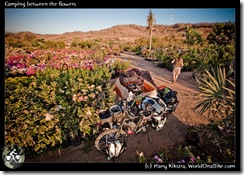 Just when we were mixing our newly discovered freeze dried soy-milk with cereals, a full-size truck pulled up at the gasstation. In the back stood more than 2 dozen kids, ranging in age from 8 to about 17. Innocent and naive as we were, we thought that this might be a poor-man’s version of a school bus, either to take the kids to school or to an excursion, as it was a weekday.
Just when we were mixing our newly discovered freeze dried soy-milk with cereals, a full-size truck pulled up at the gasstation. In the back stood more than 2 dozen kids, ranging in age from 8 to about 17. Innocent and naive as we were, we thought that this might be a poor-man’s version of a school bus, either to take the kids to school or to an excursion, as it was a weekday.
When Ivana asked the kids where they were going, the just replied with slent blank stares and took off again. The attendant explained that they were off to work in the fields, to produce the cheap fruit for export. No education for these and many other kids in Mexico, the only thing they learn is to work, and work hard.
We hit the ‘coastal road’ again but caught exactly one glimpse of the Pacific; most of the time we were just sweating up and down the few dozen smaller and bigger hills. Nothing too serious, just annoying in the sweltering heat.
Again the average temperature was above 31 degrees and we were happy that the friendly gardener that let us camp in his flowery vivero, offered us use of his garden hose and water-tank to freshen up at the end of the day.
An early start gave some refreshment, but after 35km –including already 700m/2300ft up !- it was hotter than ever and we started to curse our friendly Vallarta host that had recommended this ‘flat coastal’ road that was neither, and which we doubted he had ever been on. He definitely never had cycled it in his life.
Time for lunch, and things improved considerably when we stumbled on a nearly-deserted guesthouse, with swimming pool, fruit-dropping mango trees and an internet cafe. Heaven! Of course our lunch lasted longer than planned and we decided to camp here, being offered more mangos than we could eat. Life was not so bad after all.
Day 320, 27 May 2009: San Patricio – Manzanillo 76km, 370m up and down
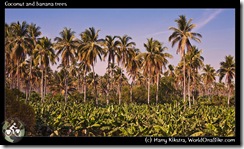 We had entered the state of Colima, which we had been dreaming about since we found out that a large part of Mexico’s fruit originates here. We were not disappointed, as the bumpy desert abruptly had given way to fields of coconut palms, mango trees and banana trees, while smaller orchards and roadside stalls offered all kinds of other natural goodies.
We had entered the state of Colima, which we had been dreaming about since we found out that a large part of Mexico’s fruit originates here. We were not disappointed, as the bumpy desert abruptly had given way to fields of coconut palms, mango trees and banana trees, while smaller orchards and roadside stalls offered all kinds of other natural goodies.
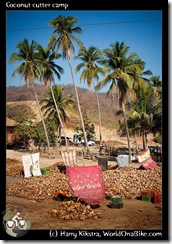 A few women were chopping enormous piles of brown coconuts in half; they only collected part of the fruit for the cosmetic industry, discarding both the juice as well as the tasty heart, so we filled up our bottles rather than letting the healthy water flow onto the thirsty sand.
A few women were chopping enormous piles of brown coconuts in half; they only collected part of the fruit for the cosmetic industry, discarding both the juice as well as the tasty heart, so we filled up our bottles rather than letting the healthy water flow onto the thirsty sand.
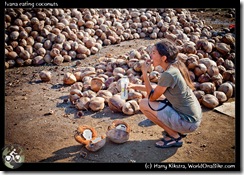 There were many mango trees with thousands of fruits dropped onto the forest floor. Apparently due to the transportation and export (to the US) hassle and cost, it is too costly to harvest and sell them so they just rot away. Except the ones that fitted in Ivana’s big Ortlieb bag of course
There were many mango trees with thousands of fruits dropped onto the forest floor. Apparently due to the transportation and export (to the US) hassle and cost, it is too costly to harvest and sell them so they just rot away. Except the ones that fitted in Ivana’s big Ortlieb bag of course ![]()
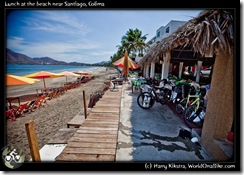 As an added bonus, the road was nearly flat and we not only got to see the ocean, we even got to touch it when stopping for lunch near a nice swimming beach.
As an added bonus, the road was nearly flat and we not only got to see the ocean, we even got to touch it when stopping for lunch near a nice swimming beach.
What goes up has to come down, even when not literally, and things deteriorated seriously after lunch. Traffic increased to annoying numbers when we approached the busy city of Manzanillo. Lack of signs made us follow a dead end street to the harbour for several km. Noise and exhaust of the buses, cars and freight trains rose to lethal levels and to top it, we got into a huge fight about which route to take. In the end I gave in and up and let Ivana decide, resulting in another detour of several kilometres.
After 75km we were more than exhausted and while still angry we rung the doorbell on a house that had a big gate and a nice garden; both necessary for a safe camp in an urban zone.
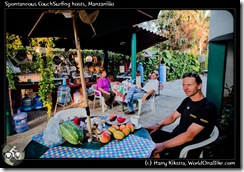 An elderly couple opened up and listened to our story. Soon they invited us, not just for dinner, but also to use one of the extra rooms upstairs, so instead of fighting and sweating in our tent, we got a shower, Mexican food and a ventilator to cool us down.
An elderly couple opened up and listened to our story. Soon they invited us, not just for dinner, but also to use one of the extra rooms upstairs, so instead of fighting and sweating in our tent, we got a shower, Mexican food and a ventilator to cool us down.
We deserved it.
Day 321, 28 May 09, Manzanillo – Boca de Apisa, 91km
 The fruity flatness continued and though the average temperature was above 31C/ 88F again, it was still a relatively pleasant ride though the field, only interrupted by a few hours of lunch in a truck-stop to avoid the heat and a short visit to the ugly City of Tecoman.
The fruity flatness continued and though the average temperature was above 31C/ 88F again, it was still a relatively pleasant ride though the field, only interrupted by a few hours of lunch in a truck-stop to avoid the heat and a short visit to the ugly City of Tecoman.
We were aiming straight for some nasty looking hills, but turned right before reaching them, back to the direction of the Ocean. We did not notice that our total recorded distance had silently increased to a 5-figure number until later that night, 10,000km (6250mi) on the road!
We had been looking forward to camping on the beach, but when we followed the 5km/3mi long turnoff, we discovered that the road literally ended at the ocean, with just a few meters of sand separating us from the big powerful waves.
 Armed with nothing much more than the knowledge that we had entered drug-trafficking country we were not being overly comfortable with the stares of some local youth and the lack of water and safe places.
Armed with nothing much more than the knowledge that we had entered drug-trafficking country we were not being overly comfortable with the stares of some local youth and the lack of water and safe places.
So, tired as we were, we headed back up to the main road and asked a farmer if we could pitch a tent on his land, which was situated next to a military checkpoint.
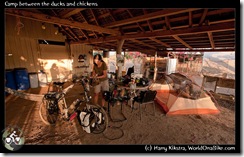 As there were dozens of different feathered friends around, Ivana preferred to camp under the roof. After being chased into our hot tent by a battalion of nasty mosquitoes, we fell into a restless sleep, blissfully unaware of the fact that I would visit 3 different doctors in 3 different hospitals in the next 24 hours…
As there were dozens of different feathered friends around, Ivana preferred to camp under the roof. After being chased into our hot tent by a battalion of nasty mosquitoes, we fell into a restless sleep, blissfully unaware of the fact that I would visit 3 different doctors in 3 different hospitals in the next 24 hours…
Kowalski! Status report!
 Mangos eaten: countless
Mangos eaten: countless- Metres climbed in 5 days on the ‘flat coastal road’: 2500+
- Average temperature during those 5 days: 31C/88F.
- Km cycled since Prudhoe Bay, Alaska: 10,020!
- Vertical meters/climbed since PB, AK: 83,460 (52 miles)
- Santos Travelmaster problems: zero.
- Knee & back report: positive, taking care and working fine.
Here are the road profiles, for those masochistic enough (or smart enough to cycle this in winter) to take it on:
Day 310-315, 17-22 May 2009: sea, dolphins & radar: World On a Boat!
August 25, 2009 by Harry, 2,146 views
Filed under Baja California, Central Mexico, Mexico, North America, Trip reports
It felt weird to cycle fully loaded once again. Once we closed the door of Brian’s apartment behind us we were back on the road, even if it was just for 5km ![]()
We headed into the Marina on the North side of La Paz as agreed with Michael & Deborah. They had come over for dinner the night before; I had prepared a kilo of shrimps that Brian had told us to use. It was spiced up with a jalapeno seasoning and Ivana had cooked an excellent curry. It was goodbye to a large kitchen again, as the Good News (the name of the boat) had a very small kitchen area and as we would often not be all awake at the same time, we would not really cook big meals anyway.
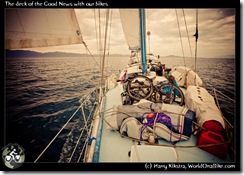 We started unpacking the bikes on the pier and I tried to make the bikes as small as possible, taking of the pedals, lowering the seats and turning the handlebars. We managed to tie both bikes and some bags at the front of the ship and the rest of the bags went inside, under our little makeshift bed next to the kitchen.
We started unpacking the bikes on the pier and I tried to make the bikes as small as possible, taking of the pedals, lowering the seats and turning the handlebars. We managed to tie both bikes and some bags at the front of the ship and the rest of the bags went inside, under our little makeshift bed next to the kitchen.
The last tests of the autopilot did not go 100% well, so we decided to do more test the next morning to prevent going around in circles later. This meant that we had to sleep at sea for the first time on our trip, but . The weather was nice and we had no problem with the calm waves, but the heat was keeping us awake.
The next level: Off to Puerto Vallarta!
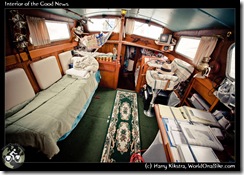 The next morning we really took off. Michael fixed the autopilot and after some restarts it worked wonderful. There was not much wind so we had to use the engine most of the time. We were just passed the port of Pichilingue (named after the Dutch port of Vlissingen!) when I saw some big as well as small things jumping out of the water.
The next morning we really took off. Michael fixed the autopilot and after some restarts it worked wonderful. There was not much wind so we had to use the engine most of the time. We were just passed the port of Pichilingue (named after the Dutch port of Vlissingen!) when I saw some big as well as small things jumping out of the water.
The big things turned out to be huge Manta Rays. Most of them were just cruising along, with only their two different coloured wingtips sticking out of the water: one side is light and the other is black as are their belly/back. But others made big jumps and floated more than a foot or two above water before falling back into the sea.
Michael thought that they might jump like this to squash parasites upon impact. Having grown up in a low grade video game era (cough..commodore..cough..64.cough ![]() ), I just felt we were entering the next level.
), I just felt we were entering the next level.
The smaller critters were flying fish, though they looked more like walking fish, staying very close to the water surface. We were still feeling ok, but were fearing seasickness the moment we would leave the safe coast and head into open water…
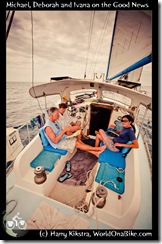 We sailed through the evening and anchored in a small bay, totally trusting our radar, GPS and depth meter (I am pretty sure there are more suitable terms for all of the things I write, but I am a rather complete Nautical N00b, as I usually stay away from sea-level as far as possible
We sailed through the evening and anchored in a small bay, totally trusting our radar, GPS and depth meter (I am pretty sure there are more suitable terms for all of the things I write, but I am a rather complete Nautical N00b, as I usually stay away from sea-level as far as possible ![]() )
)
Cleaning the dinghy and the first dolphin shows
We had been lazily enjoying the first part and had slept well, but in the morning we had our first job to do: clean the dinghy! After only a few weeks in the water, a lot of stuff had grown on the bottom of the rubber boat and it took several hours and hard labour to scrape it off on the sandy beach and then row it back to the Good News.
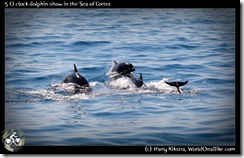 As a reward we got to see our first dolphin shows soon after: a large group of playful dolphins appeared on the horizon and soon they crossed our path, jumping out of the water as they passed. We all stood on deck, applauding when there was yet another high jump.
As a reward we got to see our first dolphin shows soon after: a large group of playful dolphins appeared on the horizon and soon they crossed our path, jumping out of the water as they passed. We all stood on deck, applauding when there was yet another high jump.
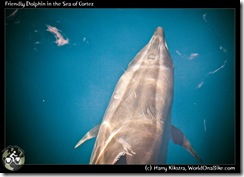 The next few days we would joke about the ‘10 o’ clock & 5 o’ clock show’ as there seemed to be a contest going on somewhere, with many groups participating. Some of them far away, others swam next to our boat and seemed to enjoy racing the Good News!
The next few days we would joke about the ‘10 o’ clock & 5 o’ clock show’ as there seemed to be a contest going on somewhere, with many groups participating. Some of them far away, others swam next to our boat and seemed to enjoy racing the Good News!
Night Vision & high powers
As we had helped successfully with raising, lowering and changing the sails and I have plenty of GPS experience, the captains trusted us to watch the boat at night. We took 2 hours shifts, with the other 3 persons sleeping.
It was peaceful and intimidating at the same time, sailing through the dark night, with hardly any difference between the water and the sky above it. Just the sound of the small waves hitting the bow and the wind in the sails in complete darkness, save a small light at the mast and the glow of the radar and GPS screens… The graveyard shift was hard and regularly I had to stand up the bench with my face into the wind to stay awake.
The 3rd night we suddenly noticed some lights ahead and got on the radio to find some sleepy Mexican fishermen floating on a couple of boats, each a few kilometres apart. As Michael knew they use huge nets, we tried to find out where they had dropped them and fortunately Ivana’s Spanish speaking skills were available. Still we barely missed some buoys, but nothing got stuck in the engine.
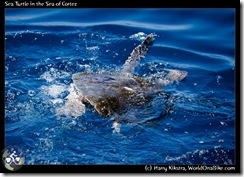 The last day, just after a huge turtle had come by and the 12 o clock show had paused, we stopped the engine and went for a swim in the middle of the deep blue ocean.
The last day, just after a huge turtle had come by and the 12 o clock show had paused, we stopped the engine and went for a swim in the middle of the deep blue ocean.
It was an eerie sight, looking underwater: with goggles, I could see the rays of sunlight disappearing into an endless depth, from light to black, erasing any sense of distance. It was refreshing though ![]()
We also had some time to talk about deeper meanings of life and travel. As Michael & Deborah were active evangelists, our conversation inevitably hit the religion bump. We believe in a separation of church and state, freedom of religion as well as from religion, and politically and socially –human rights- we were clearly also on opposite ends.
Michael was sure that there was a deeper meaning behind our journey and miscellaneous ‘talents’, even though I assured him, that we are simple, independent people and do not work by decree of Higher Powers. We would have some interesting email conversations afterwards as well, agreeing to disagree.
Still we had developed a tight friendship over the past days. Clearly even deep-rooted basic beliefs are not strong enough to hold same-minded travellers apart.
Tierra firma
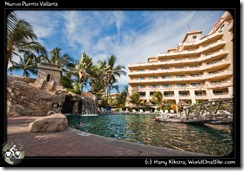 Michael had it planned well and we entered the bay of Puerto Vallarta in the late morning. We were happy we had had the opportunity to live the cruiser’s life for a few days and even happier that neither of us had gotten sick. Still it felt good to have some solid ground under our feet.
Michael had it planned well and we entered the bay of Puerto Vallarta in the late morning. We were happy we had had the opportunity to live the cruiser’s life for a few days and even happier that neither of us had gotten sick. Still it felt good to have some solid ground under our feet.
They decided to stay a night in the marina and as we were crewmembers, we also got our complimentary day pass to the accompanying resort. This meant the s-word! Swimming-pool!
 We flashed our cards to anyone around, shopped in the supermarket and spend some hours near and in the swimming pools. We almost felt one of ‘them’, if not for the fact that we sipped water from our Polar Bottle instead of Mojitos cocktails and did not spend that night on our million dollar air-conditioned boat, but in our hot tent on a deserted parking lot…
We flashed our cards to anyone around, shopped in the supermarket and spend some hours near and in the swimming pools. We almost felt one of ‘them’, if not for the fact that we sipped water from our Polar Bottle instead of Mojitos cocktails and did not spend that night on our million dollar air-conditioned boat, but in our hot tent on a deserted parking lot…
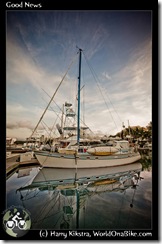 It was time to fix Kowalski & Greeny up, as we had to mutilate them to get them strapped to the boat 4 days ago. We re-connected all bits and loaded them up. We had bought some Good-Bye drinks and wished our new friends a safe journey South.
It was time to fix Kowalski & Greeny up, as we had to mutilate them to get them strapped to the boat 4 days ago. We re-connected all bits and loaded them up. We had bought some Good-Bye drinks and wished our new friends a safe journey South.
Though we still did not know which road to take it was clear that it was time to hit the road again. We have to be in Cancun in 5 weeks time to pick up our mums from the airport. Mexico is simply huge and there is so much to see everywhere. Even with some rides, we will never be able to make this distance, roughly 3200km/2000mi, in time, so we need to make some choices soon..
Will we make it? Any way, Central Mexico, here we come!


